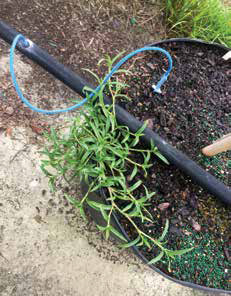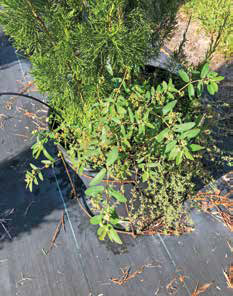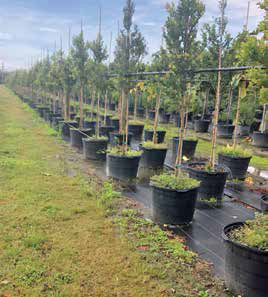Building Better Rotations
Timing Pre-emergence Herbicide Applications When They Benefit You Most
By Dr. Chris Marble, UF/IFAS Mid-Florida Research & Education Center
Of all the pests, weeds are the most unbiased. No matter what kind of production environment is created, there will be a weed species that can thrive in that situation. Weeds are, of course, unsightly, but they can also dramatically increase production times by reducing crop growth by as much as 70% or more. Luckily, there are some great pre-emergence herbicides that you have at your disposal. Proper selection and application of these herbicides can help tilt the balance of power back in your favor.
So how should herbicides be selected? In reality, your crop mix and the common weeds in your area and nursery will determine what herbicides will work for your situation. I like to think of herbicides as tools, in that they can all be useful for different or specific jobs. Most jobs are going to require different tools and weed management is no exception. A solid herbicide rotation will utilize different herbicides with different modes of action at different times of the year.
Building a rotation for your nursery can be broken down into four steps:
1) Determining which herbicides are safe for your crops
2) selecting herbicides for key weeds each season
3) optimizing your herbicide applications for when they’ll be most useful
4) rotating through different modes of action.
Determining what herbicides are safe for your crops
There are two key considerations to consider when selecting the best herbicides for your operation: 1) crop safety; and 2) spectrum of control the herbicide offers or efficacy. The first thing most growers consider is crop safety. This makes sense because if the herbicide injures many of the plants you grow, then that herbicide might not be the best option. However, it’s important to keep in mind that not all ornamental plants have been tested for every herbicide—there are just too many to test them all (but we’re working on it!).
This is where efficacy comes in to play. If an herbicide is highly efficacious on a particular weed, but some ornamental species you grow aren’t listed on the label, small-scale plant safety trials may be necessary. In fact, testing plant safety be-fore wide-scale application is recommended in many cases.
Let’s take spotted spurge as an example: Spotted spurge
is one of, if not the most, problematic warm-season weeds
in container production. FreeHand is an excellent choice for spurge control, and while it’s labeled for use on hundreds of ornamental species, you may have some species that aren’t on the label. As FreeHand is a good option for spurge and is safe on most woody ornamentals, some small-scale testing might be warranted to determine if it could be used on other orna-mental hosts not listed on the label.
Consider key weeds each seasonConsider key weeds each season
Depending on the herbicide and the rate, you’ll be allowed two or sometimes three applications per year. The key to good herbicide performance (besides sprayer calibration) is utilizing those two or three applications when they’ll be most beneficial to you, which is determined by your most problematic weeds each season. Before you schedule your herbicide applications, first determine what the most important or problematic weed is each season. After figuring out what your worst weed is, determine what your second or third most problematic species are. These species aren’t as common or troublesome as num-ber one, but are still an issue.
Next, find the herbicide that’s effective on your worst weed. This information can be found on herbicide labels, manufacturer websites, university webpages and in regional guides such as the 2017 Southeast Pest Management Guide for Nursery Crops. The first priority is to select an herbicide that’s highly efficacious on your worst weed and also has some efficacy on your problematic secondary weed species. Even if these species aren’t a big problem now, any uncontrolled weed can take over. It’s important to select an herbicide option that’s effective on all or at least most of your weeds each season.
 Doveweed (Murdania nudiflora)
Doveweed (Murdania nudiflora)
 Spurge Species
Spurge Species
 Bittercress Infestation
Bittercress Infestation
Many efficacy charts rank herbicide efficacy using a sys-tem such as either “Good,” “Fair” or “Poor” for different weeds. For your number one weed, you want a good or the best op-tion you can use depending on your crop mix. If your number two or three weeds aren’t that problematic, something that’s ranked as Fair might work, as long as it’s good on the worst weed.
Optimizing herbicide applications when they’re most useful
After looking at different efficacy charts, you’ll quickly realize that there are more herbicide options for some weed species compared to others. For example, in the cool-season, oxalis might be a big issue, but you would have many herbicides to choose from that offer a high level of control of oxalis and other cool-season species like annual bluegrass or bittercress.
Alternatively, there are limited chemistries available to control warm-season weed species like doveweed. Options for doveweed control include FreeHand, Tower, Marengo or Broadstar. All four of these herbicides also control oxalis, but since you only get two applications per year, you may want to reserve these products for doveweed season. In this specific scenario, a product like FreeHand will give you the most bang for your buck during the summer months when doveweed, spurge and other warm-season weeds like phyllanthus are most problematic.
Herbicides can be used in different seasons and no single rotation program is going to work for every nursery. There are many possibilities depending upon your specific situation. The key point to remember is to apply herbicides during the season when they’ll benefit you the most based on your weed pressure.
Building a rotation schedule
After determining what herbicides are safe for your crops and which herbicides will work on the common weed species at your nursery each season, you’ll have narrowed down your list of potential chemical options. The next step is to look at the herbicide mode of action (or modes of action in combination products) to determine how to best rotate those herbicides each season. While there are many pre-emergence herbicides and combinations available, there are only a few modes of action available, including Weed Science Society of America Groups 3, 14, 15, 21 and 29.
The best results are usually achieved when no herbicides or combinations are applied in back-to-back or sequential applications. For example, if you applied a Group 3 + 14 com-bination at potting, you wouldn’t want to follow that up with another 3 + 14 combination. If there’s a weed species that a 3 + 14 combination does control, a back-to-back application would allow more time for that weed to take over and spread before another herbicide is applied.
Rotating can also increase crop safety. Some plants can tolerate one application of some herbicides, but not sequen-tial applications. There might not be observable injury imme-diately, but injury could occur over time in some cases. Keep in mind that some herbicides shouldn’t be applied at potting, therefore potting schedules may limit your herbicide options at different times throughout the year.
The number of different herbicides you may need in your rotation product depends on many factors, but good pro-grams can be built with four or five different herbicide prod-ucts. This is largely dependent on the number of applications you need to apply each year or growing season. In most cases, an application every eight to 10 weeks during the growing season is recommended to control weeds before they become problematic.
By following these steps, you can develop a list of herbi-cides that will work for your crops, control your weed spec-trum and know how you’ll rotate them with different modes of action with your new herbicide program. Now just imple-ment, scout regularly and adjust if needed.
Originally published in the 2020 GrowerTalks IMF Guide.

